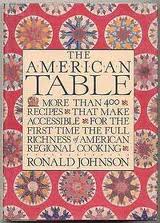Ronald Johnson’s colonial chicken pudding.
This simple batter pudding boosts the flavor even of supermarket chickens. It takes a little time--you make your own stock--but it is not at all difficult and requires no concentration or even attention while the stock simmers slowly for an hour. If, however, you skip the process of making stock and substitute some from the store, you will lose a little richness but gain a lot of time. For four.
 For the stock:
For the stock:
-a chicken cut into 10 pieces
-2 roughly chopped carrots
-2 roughly chopped celery stalks with their leaves
-a quartered unpeeled onion
-4 parsley sprigs
-2 bay leaves
-1 generous teaspoon dried thyme
-Worcestershire
-Kitchen Bouquet (optional; see the notes)
-some whole peppercorns
For the batter:
-1¼ cups flour sifted with ½ teaspoon salt
-½ teaspoon baking powder
-3 beaten eggs
-1 cup milk
-2 tablespoons softened unsalted butter
For the filling:
-about 3 Tablespoons flour (preferably Wondra; no lumps)
-salt and pepper
-cayenne
-merest hint of mace (optional; see the notes)
-2 Tablespoons olive oil
- Make the stock by dumping the back, neck, wingtips and giblets except for the liver into a pot with all the other ingredients listed for the stock along with about a quart or so of water. Any other chicken scraps with bone will of course also do.
- Simmer the covered stock for at least an hour, preferably two, and strain it. Toss the solids.
- Make the batter by combining all the ingredients listed for it and beating it with a hand blender or in a conventional blender until frothy. Let it rest for half an hour or so.
Preheat the oven to 450°. - Whisk together the 3 Tablespoons of flour and its seasonings and toss the chicken in it.
- Melt the 2 Tablespoons of unsalted butter over high heat and fry them until deep gold.
- Pour enough of your stock into the skillet to rise halfway up the side of the chicken pieces, bring it to a boil, reduce the heat to a simmer and cook the chicken through, usually for about 30 to 40 minutes.
- Pour the olive oil into a baking dish just big enough to hold the chicken snugly in a single layer; it should not be much more than 2 inches deep.
- ‘Bake’ the olive oil for 10 minutes, then set the chicken pieces in the dish, pour the batter over then--be careful not to spatter yourself with hot oil--and bake the pudding for 15 minutes.
- Reduce the oven temperature to 350° and cook the pudding until the batter rises and turns golden, usually in about 25 to 30 minutes.
- While the pudding bakes, make its sauce by whisking your stock into the skillet in which you fried your chicken, making sure to rip all of the debris from the surface of the pan.
- Whirlpool the sauce with a hand blender (or put it in a blender then return it to the skillet until smooth, bring it to a boil and reduce it to a simmer for a minute or two. Serve in a pitcher with the pudding.
Notes:
- A poetic dish; the britishfoodinamerica recipe is modified from Johnson’s in The American Table (Weston CT 2000). As he in turn notes: “It is much more interesting than any of the various pot pies, etc., and is quite a simple dish to master. It makes even a quite ample company meal with a good white wine, a fresh light soup before, an interesting salad or vegetable after, and any outstanding dessert.” (Johnson 150) If you choose a vegetable over the salad, we would serve that with the pudding instead of afterwards.
- Johnson’ recipe does not include the baking powder, cayenne or mace, but they are traditional British components. No peppercorns, Worcestershire or Kitchen Bouquet either; this last gives the stock a greater depth and deeper color, like the unpeeled onion (Johnson peels his).
- As noted in the introduction, if pressed for time you can skip Steps 1 and 2 by substituting store bought stock. The new Swanson ‘bold’ line that come in little capped cylinders is not bad. In the UK, stock concentrates kept in the refrigerator case are pretty good. If you do use commercial stock, then add the bay, thyme, cayenne, possibly mace, Worcestershire and Kitchen Bouquet at Step 6.
- Some people dislike mace; skip it if you are among them.
- Johnson combines melted butter with the eggs and milk before pouring the mixture into the flour; we fear that the procedure risk curdling the eggs with the hot butter so have changed it.
- The pudding is even better if you sprinkle about ¾ cup of good ham or bacon cut into smallish dice around the chicken before adding the batter at Step 8.
- You might also strew some grated parmesan over the pudding when you reduce the oven temperature to 350°.
- The Editor likes to incorporate a generous teaspoon of dry mustard into the batter. Colman’s always is good.

